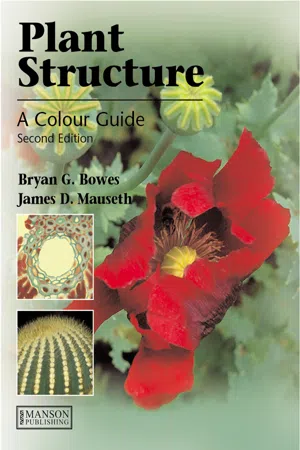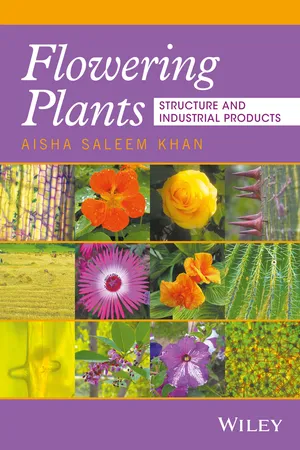Biological Sciences
Angiosperms
Angiosperms are flowering plants that produce seeds enclosed within a fruit. They are the most diverse group of land plants and play a crucial role in ecosystems as food sources for animals and humans. Angiosperms have specialized reproductive structures, such as flowers, which have contributed to their evolutionary success and widespread distribution.
Written by Perlego with AI-assistance
Related key terms
3 Key excerpts on "Angiosperms"
- eBook - ePub
- Bryan G. Bowes, James D. Mauseth(Authors)
- 2008(Publication Date)
- CRC Press(Publisher)
CHAPTER 1Introduction
THE ASSORTMENT OF LAND PLANTS
Flowering plants, or Angiosperms (1 , 2), dominate large areas of the land surface and represent the climax of vascular plant evolution. They occupy a wide range of habitats and about a quarter of a million species have been recognized so far. However, many more, particularly from tropical regions, await scientific description. Angiosperms are very diversified in their form, and range in size from a few millimetres in diameter in the aquatic Lemna (3 ) to 90 m or more in height in Eucalyptus (4 ). Some complete their life cycle in less than 2 months while some specimens of Quercus (oak) may live nearly a thousand years (5 ).Flowering plants provide the vast majority of those consumed by humans (6 , 7) or utilized for domestic animal fodder. Likewise, Angiosperms provide various very important commercial hardwood timbers such as Acacia, Carya, Eucalyptus, Fagus, Juglans , and Quercus (4 , 8 , 9), fibres (e.g. Corchorus, Linum ; 10 ) and drugs (e.g. Papaver, Coffea ; 7 ). Most decorative garden plants are grown to provide floral displays (1 , 2).Although the flowering plants are now dominant in many habitats, remnants of earlier evolved vascular plant groups are still present in the flora. There are about 700 species of gymnosperms whose seeds are naked (11 ); these are mostly conifers (12 ) but there are also some 289 tropical/sub-tropical cycad species (11 ) and a few others. Their naked seeds distinguish them from the flowering plants where the seeds are enclosed within a fruit (13 ). The conifers dominate the vast tracts of boreal forest which occur in North America and northern Europe and Asia, and many conifers provide very valuable softwood timbers for a multitude of purposes such as construction, paper pulp, and fencing. The spore-bearing ferns and their allies (14 –16 - Barbara A. Ambrose, Michael D. Purugganan(Authors)
- 2012(Publication Date)
- Wiley-Blackwell(Publisher)
Chapter 6 IDENTIFYING KEY FEATURES IN THE ORIGIN AND EARLY DIVERSIFICATION OF Angiosperms Paula J. Rudall Royal Botanic Gardens, Kew, Richmond, Surrey, UKAbstract: Understanding the origin and early diversification of the flowering plants (Angiosperms) represent primary goals in biology. However, despite extensive knowledge of angiosperm biology and biodiversity, much remains to be determined about their evolutionary origin, partly because many of their characteristic (some supposedly diagnostic) features probably evolved iteratively among seed plants. This chapter focuses on the early evolutionary history of the “key” angiosperm reproductive structures: carpels, flowers, and inflorescences. It discusses some of the major morphogenetic markers that circumscribe deep nodes within the Angiosperms, notably the base of the eudicot clade. Despite recent advances in comparative genomics and developmental genetics of an increasing range of model organisms, satisfactory resolution of longstanding and fundamental questions regarding angiosperm origins remain hampered by the problematic phylogenetic framework for seed plants, which is notable for strongly contrasting hypotheses based on molecular versus morphological data. Ongoing integrated comparative studies can potentially clarify floral evolution within Angiosperms.Keywords: angiosperm; canalization; carpel; development; evolution; flower; inflorescence.6.1 Introduction: key features of flowering plantsToday, the flowering plants (Angiosperms) represent by far the most species-rich group of land plants, dominating floras and habitats throughout most of the world. They are the primary food source for most land animals, including humans. Several potentially key features are widely hypothesized to characterize the Angiosperms, including flowers, carpels, columellate pollen, non-motile sperm, elongated pollen tubes with callose plugs, double fertilization leading to endosperm production, highly reduced megagametophytes and microgametophytes, an outer integument enclosing the ovule, paracytic stomata, and vessels in the secondary xylem (e.g., Doyle & Donoghue 1986; Williams & Friedman 2004; Rudall 2006; Rudall & Bateman 2007; Williams 2008; Doyle 2009). However, despite extensive knowledge of angiosperm biology and biodiversity, we remain unclear about precisely how to circumscribe the Angiosperms (and hence even more perplexed about non-angiospermous seed plants, the gymnosperms), because many of these important angiospermous features are either difficult to interpret, absent from some early-divergent Angiosperms, or probably evolved more than once among seed plants.- eBook - ePub
Flowering Plants
Structure and Industrial Products
- Aisha S. Khan(Author)
- 2017(Publication Date)
- Wiley(Publisher)
endosperm (nutritive tissue around embryo within seeds), flowers with carpels and stamens having two pairs of pollen sacs and phloem for transportation of sugars. Their fossils are over 135 million years old. Angiosperms are considered to be close relatives of living gymnosperms but some recent evidence suggested that seed ferns represent sister group to Angiosperms. They are relatively evolved group of plants as compared with gymnosperms as they possess several mechanisms which ensure successful asexual and sexual reproduction, one of the main reason which makes them one of the abundant group of seed plants.Although monocots (Angiosperms with one cotyledons) and dicots (Angiosperms with two cotyledons) are referred as two main groups of Angiosperms but modern classification which is based on molecular evidences have characterized Angiosperms as core and basal Angiosperms according to their monophyletic origin (descendants of common ancestors) and facts provided by molecular data including studies from DNA sequences from chloroplasts gene rbcL. Therefore, modern system of plant taxonomy, that is, Angiosperms Phylogeny Group (APG) system is a molecular‐based systematics which retains order and families of Linnean systems and includes groups which are monophyletic. APG I was published in 1998 which was followed by APG II in 2003 (Chase et al., 2003) and APG III in 2009 (Bremer et al., 2009) and then APG IV in 2016. However, further development in molecular techniques, advancement in techniques related to metabolomics and proteomics is exploring the molecular phylogenetics which will form foundation of evidence‐based classification of flowering plants.Evolutionary evidences suggest that basal Angiosperms which are characterized by absence of xylem vessels are primitive, however, some recent phylogenetic analysis reported that Amborella trichopoda is sister to all extant Angiosperms and is at the base of Angiosperms phylogenetic tree. They are composed of only few species which include many aquatic plants like water lilies (Figure 1.1 ), Amborella and star anise. Core Angiosperms are represented by monocots and core eudicots. They include three major groups including monocots, eudicots and magnoliids
Learn about this page
Index pages curate the most relevant extracts from our library of academic textbooks. They’ve been created using an in-house natural language model (NLM), each adding context and meaning to key research topics.


